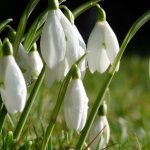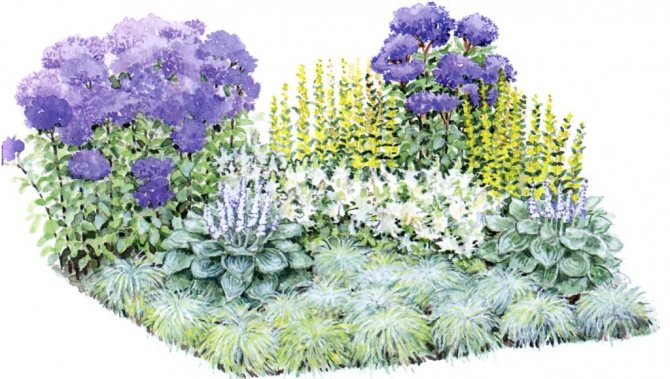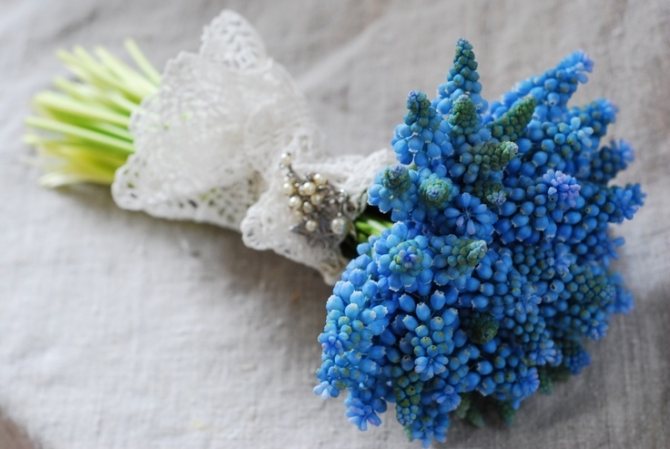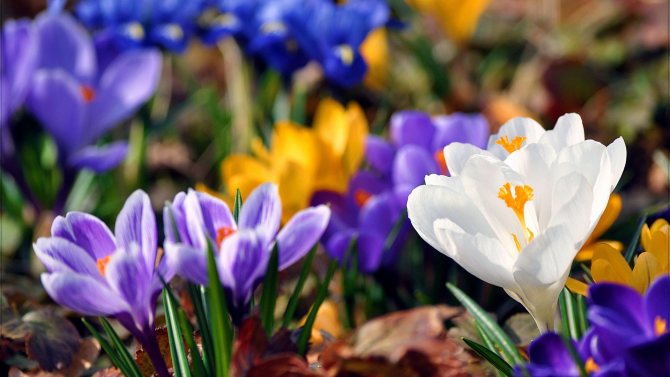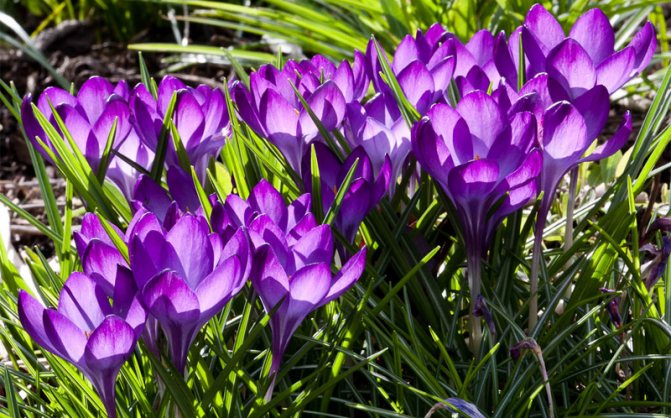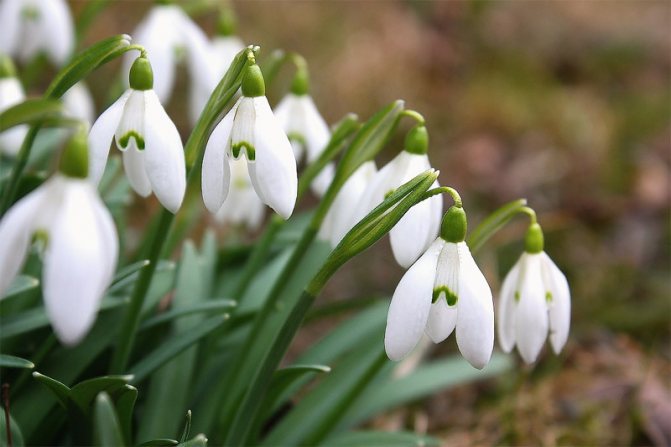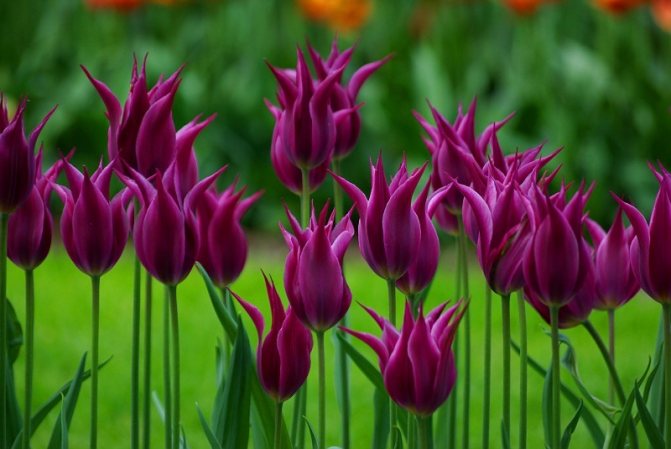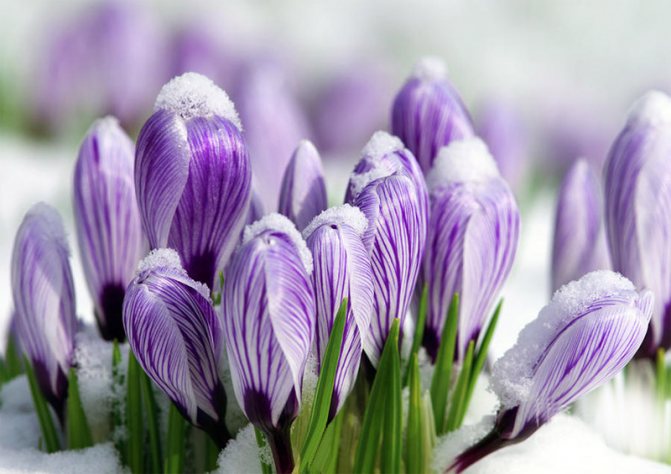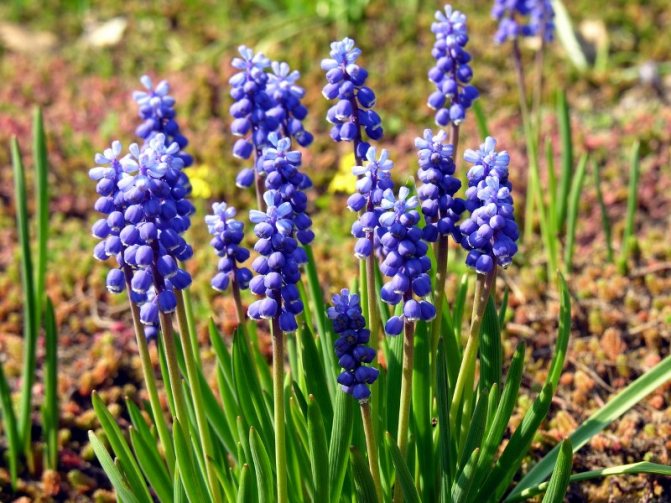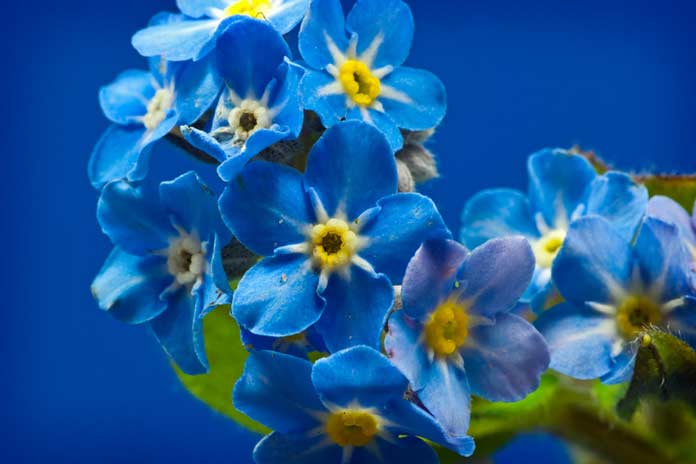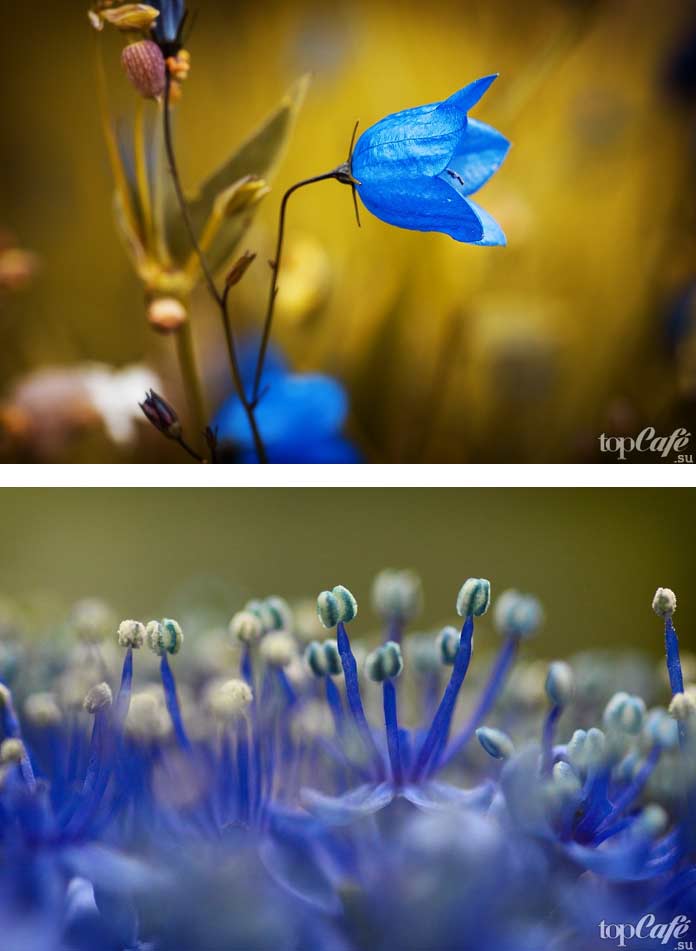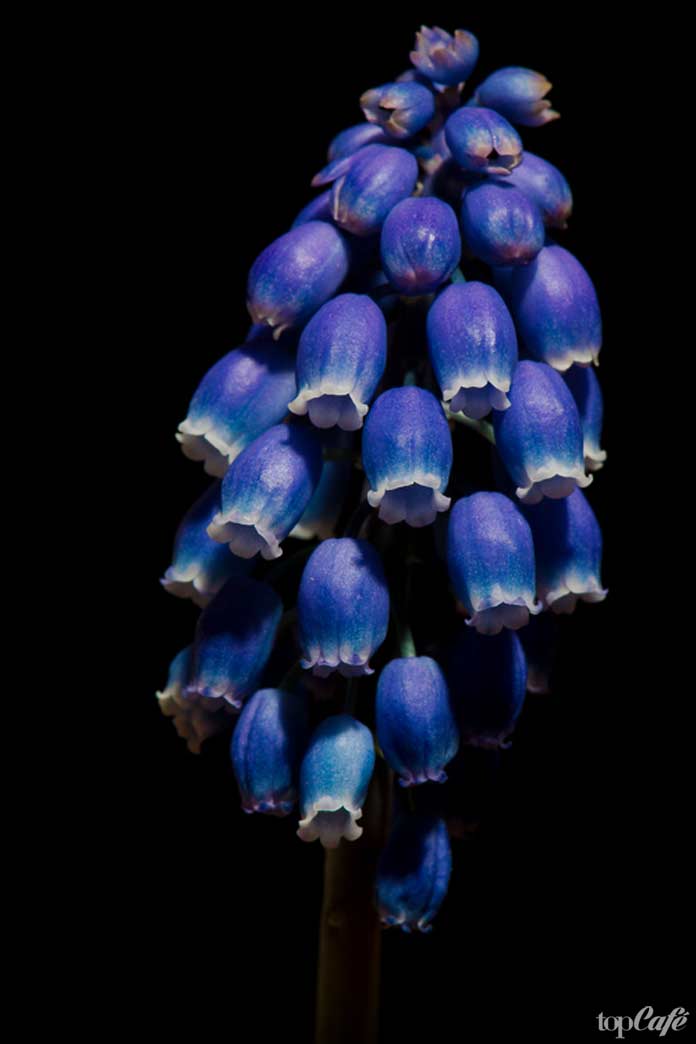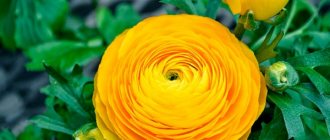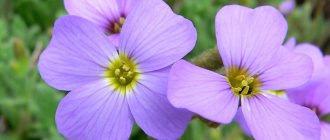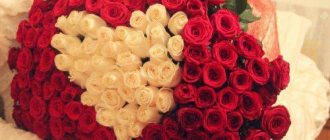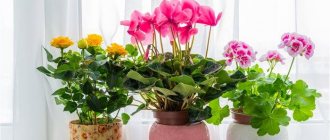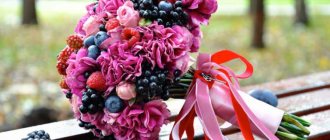Blue is the rarest color in the world of flowers. Blue flowers have a special place in our hearts and in our gardens.
Blue shades stand out primarily for their rarity, but also for their ability to contrast with pinks, reds, yellows, whites and other shades in the color scheme.
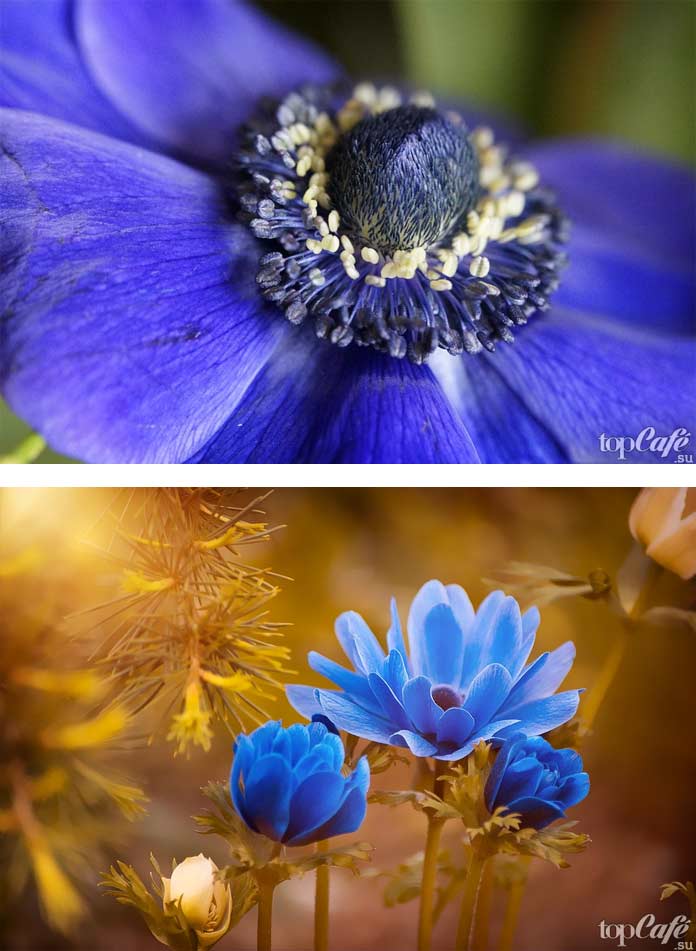
In the photo: Anemones.
Blue is the color of calm and tranquility. Blue flowers have a calming effect on us. They are also a sign of love, respect and desire. Natural blue stands for loyalty, trust, intelligence, wisdom, faith and confidence.
Next, we present to you a collection of beautiful blue and light blue flowers. Look at them, plant them at your place and we are sure that they will take a special place in your heart.
TOP 10 beautiful blue flowers that will decorate your home and garden:
10
Snowdrop (galanthus)
The first spring flower blooms in late winter or early spring. This is an ornamental plant loved by many gardeners. When closed, its flower resembles a droplet or earring.
There are over 20 types of snowdrop. Most of them do not smell good. Snow-white snowdrop is widespread in modern gardening. Its various varieties differ in the size and shape of the flower.
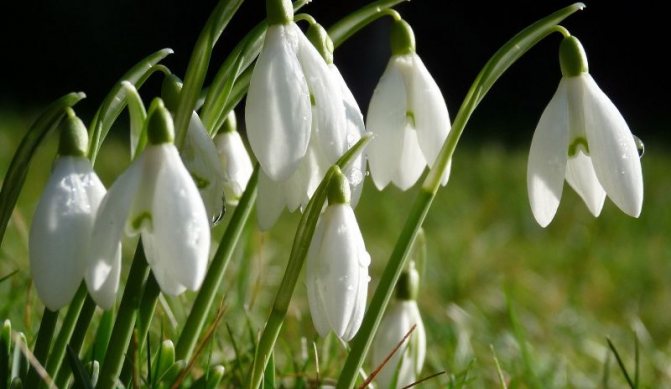

Primroses look best in the garden in groups of 10-20 plants. Single flowers do not look so impressive. Immediately after a short flowering, snowdrops quickly fade, leaving no withered foliage and not deteriorating the decorative qualities of the flower garden.
Galanthus are unpretentious and resistant to adverse weather conditions. They can grow quickly, filling free space in the forest or on the site.
Snowdrops should be planted from mid-June to November, when the bulbs are at rest. For them, it is better to select open areas. Snowdrops do not like heavy soils and excess moisture.
We also recommend reading:
Features and options for glazing verandas and terraces of private houses A country house with a patio: features of drawing up a project and options for a beautiful design Porch for a private house: design and decoration options How to make an extension of a veranda to a house with your own hands?
Blue iris
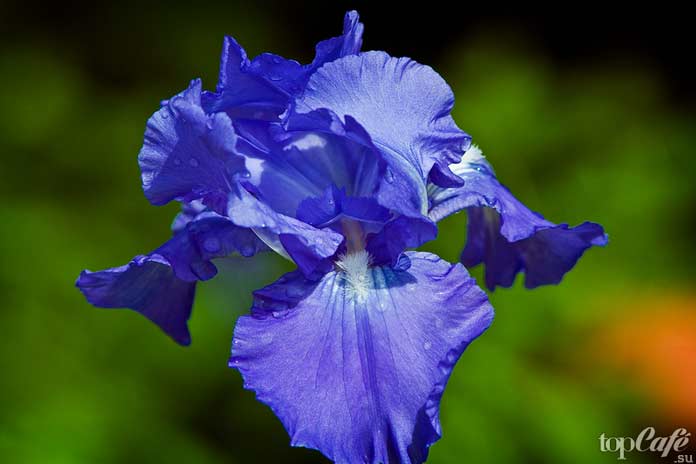

Whether they are toothed or not, iris flowers are for many the brightest representatives of blue flowers. There are about 250-300 types of iris. They took their name from the Greek word "rainbow" and are not only blue, but also white, yellow, purple, red and even motley.
The great artist Vincent van Gogh loved to depict iris flowers in his paintings. They are associated with wisdom, faith, friendship, hope and valor.
3
Tender forest
Delicate miniature spines (they can be called scyllas), appearing in early spring, are known to many. There are about 90 species of this plant. In the European part of Russia, 2 types of forest forests are most often found - Siberian and two-leaved. They are often called blue snowdrops. The woodlands grow so close to each other that from a distance they resemble a blue carpet. The earliest species are shown on the surface of the earth in late February - early March.
Numerous varieties of Proleski are derived mainly from the Siberian Scylla. Varietal plants have a different color of flowers.Proleska Mishchenko in spring blooms with white bells with a bluish tint and a blue vein. Proleska Socialis is covered with small purple-green flowers. In the Peruvian redwood, flowers look like stars and are collected in rounded brushes. They are painted in dark blue with a bluish tint.


The Spanish spit is often grown in the garden. It covers the area with a blue or purple carpet from April to May. Sometimes there are pink and white color of flowers that have the shape of bells. The height of a flowering plant can reach 40-50 cm.
Carpets are unpretentious. They are easily propagated by bulbs and seeds. It is enough to plant a group of primroses once in a sunny area to enjoy their flowering for many years without much hassle.
Viper onion (grape hyacinth)
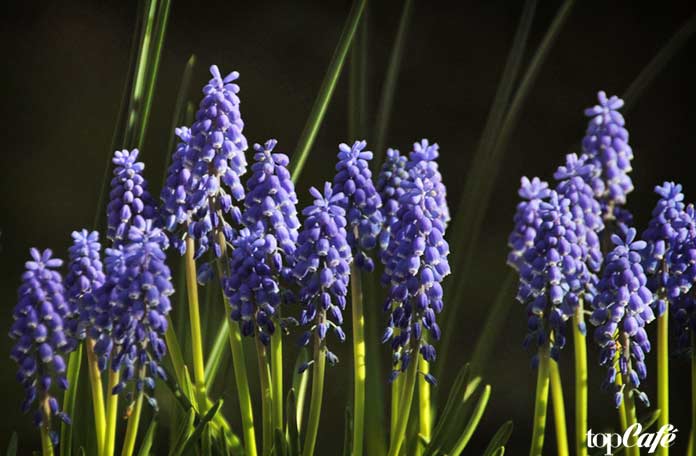

It is a pleasure to watch the appearance of grape hyacinths in early spring. Luxurious blue flowers are similar to hanging bunches of grapes, although shades are different - purple, white, yellow varieties.
Grape hyacinths belong to the genus muscarines. It is a perennial bulbous plant native to Eurasia. They mean rebirth, constancy and trust in a person.
7
Gorgeous crocuses
The incredible beauty of crocuses is mesmerizing. There are about 80 types of these stunning flowers. Their petals differ in shape and color. There are plain crocuses (snow-white, purple, lilac, lilac, blue and creamy yellow) and two-color.
Plants reach a height of 8-15 cm. Gardeners successfully grow both wild flowers and artificially bred varieties and hybrids on their plots. Some varieties of flowers can have both blue and yellow petals.
Early flowers are divided into botanical and large-flowered. Botanical plants appear immediately after the snow melts between late February and early April, depending on the region and weather. They rarely grow taller than 10 cm and are distinguished by small buds. It is better to plant them in groups of several. The most popular botanical varieties are Blue pearl, Cream Beauty and Prins Claus.


Early spring flowers Blue pearl have a blue-white color that resembles pearls. They appear very early. At Cream Beauty, the flowers are colored in an unusual creamy color. Their stigmas are orange. Prins Claus crocuses are considered the most beautiful representatives of the species. They have white petals with a bright purple center.
Large-flowered crocuses bloom 7-10 days after botanical, around mid-April. The most famous varieties of Dutch crocuses were obtained by crossing large-flowered species. Most often, gardeners plant the following varieties: Jeanna D`Ark, Pickwick, FlowerRecord.
Crocus Jeanna D`Ark is recognized as the best by florists. On its snow-white petals there are subtle light lilac strokes, which become dark purple closer to the base. The large Pickwick flower has unusual lavender veins on its petals. The FlowerRecord variety will surprise you with a rich purple shade of a massive flower. Ideal for decorating rock gardens.
The first spring flowers are best planted in sunny and well-heated areas. In the shade, the buds may not open. Almost all crocus species do not like acidic soils. Planting and replanting of bulbs is carried out from June to August. It is necessary to store the corms at a temperature of 17-20 ° C. They are planted before winter.
Blue clematis
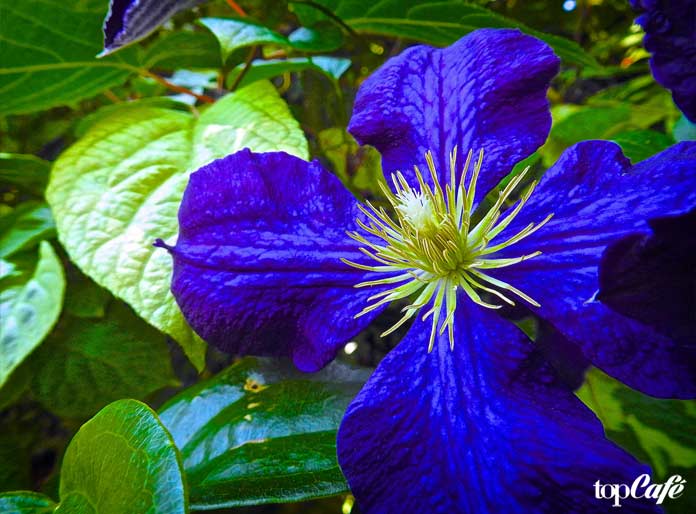

Crystal Fountain, Blue Ice and Arbella are varieties of clematis that have true blue hues. The spectacular flower grows on lush stems. They love to plant it in both European and Asian gardens. Blue clematis stands for loyalty, resourcefulness, and courage.
The genus of clematis includes about 300 species of flowers of the buttercup family. The wild species of these flowers are native to China.They became popular in the 17th century, first in the gardens of Japan, and then in the 18th century spread to European countries. They symbolize intelligence and craving for art.
6
Gallery: spring flowers for the garden (25 photos)
Classification of flowering plants
All flower crops grown in the open field are divided according to biological characteristics: annuals, biennials and perennials.
The group of annuals includes flowers that develop, bloom, give seeds and die during one season. Beautifully flowering crops of this species are most popular in garden art due to the richness of varieties and shades, as well as because of the ability to create new flower arrangements every year.
After flowering, the garden bed can be prepared for the next season, without fear of damaging the plant roots, and planning a new planting scheme. Typical annuals are asters, cornflowers, petunias, sweet peas, blue salvia and others.
Biennials include plants in which abundant flowering occurs in the second year of life. Under favorable conditions, some crops can grow for more than two years. The famous names for blue flowers are viola, bell.
The most valuable group of plants for garden decoration is flowering perennials that can maintain their decorative effect for 5-15 years. In most representatives of the group, by the end of the growing season, the herbaceous aboveground parts die off, and the underground shoots remain in the ground and resume growth with the onset of warmth.
By morphological characteristics, perennial crops are divided into groups:
- rhizome (irises, lupine, phlox, aquilegia);
- bulbous (chionodoxa, hyacinths, blue spines);
- corms (corydalis, gladioli);
- tuberous (blue anemone, gloxinia).
To create bright and harmonious compositions, perennial crops are divided according to economic characteristics: the shape of plants, the color of petals and leaves, use in the garden (for flower beds, ridges, mixborders, slogans, alpine hills, portraits, ornaments).
The following flower crops are distinguished by use:
- carpet;
- curb;
- curly;
- ampelous.
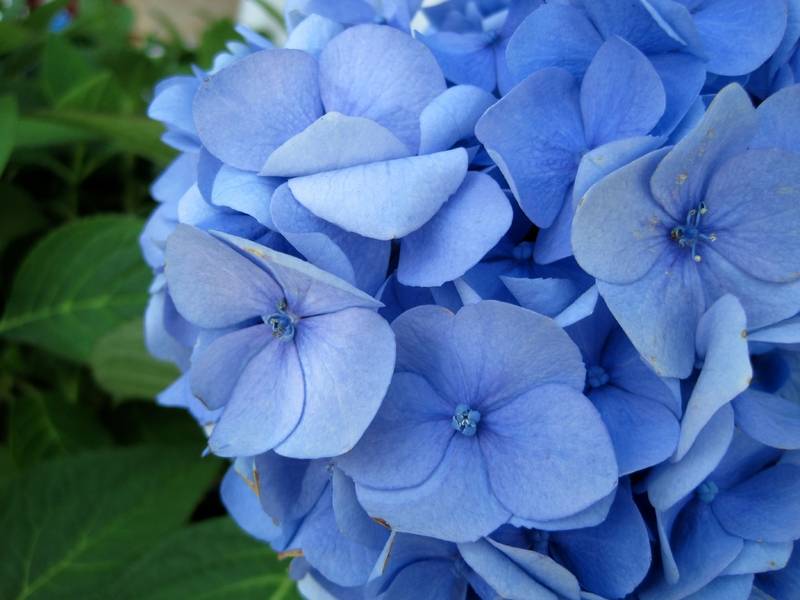

Bright liverwort
In the European part of Russia, already at the beginning of April, you can find the noble liverwort with azure-bluish or pink flowers. In the Far East, her relative, the Asian liverwort, is growing. The squat perennial blooms from April to May with white, pink or purple flowers.
Gardeners often plant liverworts on their plots. Primroses appear even before the snow melts. They bloom magnificently for 6 weeks and delight with the rich color of the petals. After the end of flowering, leaves begin to grow. Therefore, instead of a bright carpet, a green lawn appears on the flower bed.
Different and lovely
Among the plants, in the range of colors of which there are not only bright and warm shades, but also purple and pale blue, the following can be noted:
- delphinium;
- morning glory;
- cineraria.
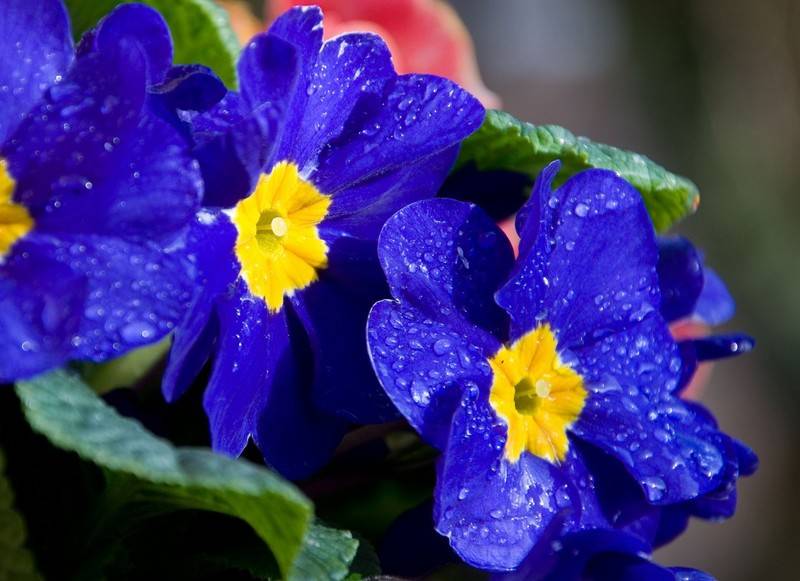

Delphinium is a plant of both annual and perennial species. It blooms in large flowers, on high legs-arrows. Delphinium care is pretty simple, and even a novice gardener can handle it. All you need to know about it is that the plant loves the sun in the morning and negatively tolerates stagnant water. The range of shades that nature has endowed with the flowers of the plant varies from white to deep purple.
Ipomoea bindweed blooms with multi-colored buds up to 6 cm and smells good. What kind of morning glory is in a variety of colors is not hard to imagine. Due to its curly properties, it is ideal for decorating fences, arches and gazebos. It grows well both in the shade and in the sun and blooms all summer and the first autumn months.
The aster annual, called cineraria, blooms in large flowers that resemble gerberas. The color schemes in which this herb is found include all shades of the rainbow.Cineraria loves humid air and well-lit areas, but does not tolerate direct sunlight.
The modern abundance of decorative fauna can satisfy the most strict and refined taste of the gardener. Every year, craftsmen-selectors continue to develop more and more flowering plant varieties that are able to decorate a flower bed, flowerpot or a backyard meadow in a new way.
Beauty primrose
Primrose is one of the favorite primroses among gardeners. The origin of its second name (keys) is associated with an ancient legend. The peoples of northern Europe believed that the keys with which the goddess Freya opened the spring were in the form of primrose flowers.
The area of the plant covers Europe, Asia Minor, the Urals, the Caucasus and Iran. More than 500 species of primrose are known. Primrose loves moist and sunny places. It grows in meadows near streams, rivers and lakes. But on a personal plot it is better for her to find a place in the shade of fruit trees and bushes. Primrose loves well-drained, loose and moisture-absorbing soils.
The high primrose is distinguished by its unpretentiousness and resistance to bad weather conditions. It blooms in April and blooms for 1.5 months. On a peduncle reaching a height of 30 cm, there are light yellow flowers with a diameter of 1.5-2 cm.


Many varieties and hybrids have been bred from tall primrose. Alba primroses will surprise you with their snow-white color and yellow throat. Primrose Colossea has crimson petals with a yellow throat. The dark blue color and yellow throat characterize the flowers of the Cerulea cultivar.
The fine-toothed primrose has a spherical inflorescence. It rises on a long thick peduncle reaching a height of 70 cm. Even a young rosette of leaves with recently appeared buds looks elegant. Small-toothed primrose blooms in April and pleases with flowering for 30-45 days.
Plant seeds are planted in boxes immediately after harvest. Saplings are planted in open ground in spring or autumn in the second year of life.
Forget-me-nots
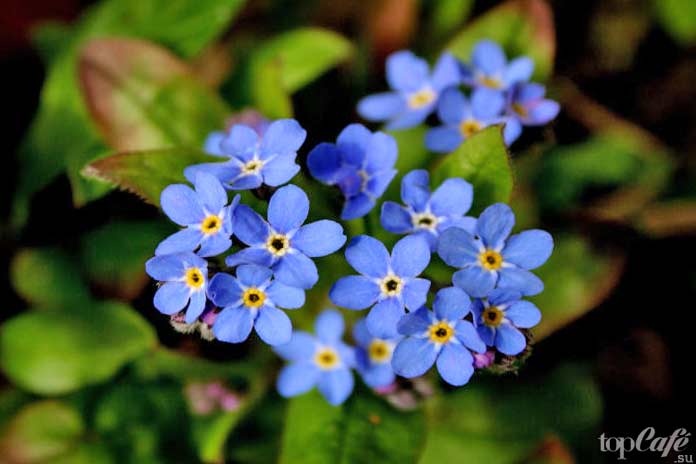

Blue forget-me-nots have long been a symbol of true love and memory. In the 15th century, people believed that the couple who always carried forget-me-nots with them would never forget each other.
Forget-me-nots belong to the genus myosotis from the boraginas family. The name of the flower comes from the Greek "miosotis" - "mouse ear", which describes the petals of the flower. The forget-me-not alpestris is the official flower of the state of Alaska and the province of Dalsland in Sweden.
2
Fragrant May lily of the valley
Delicate snow-white bells look touching and delight with a delicate aroma. The plant is widespread in the wild. Its range covers almost all of Europe. Lily of the valley is found in the Far East and North America. It blooms in May.
Many gardeners willingly plant a wild plant on their backyard by digging it up in the forest. However, there are interesting decorative varieties of lily of the valley.


Albostriata looks unusual because of the thin, light longitudinal stripes on the foliage. White flowers are almost indistinguishable from wild ones. The Flore Plena plant has ordinary leaves and double bells. From a distance, the flowering Flore Plena lily of the valley resembles foam. Rosea flowers have a light purple-pink hue.
Blue aster


Butterflies love asters, just like us. They bloom, spilling out their gorgeous blue color, in late summer and early fall, after the other flowers have finished their season.
Aster belongs to the genus of flowering plants of the Aster family, which number about 180 species. Aster takes its name from the ancient Greek word "astr", meaning "star" from the shape of their flowers.
In 1918, the Hungarian revolution was dubbed the "Astral Revolution" because of the protesters who wore the aster flower as a symbol of their unity and solidarity.
4
Spring adonis
It is believed that the plant was named after the ancient Greek god Adonis. Bright yellow flowers appear on the surface of the earth in the first sunny days of spring.Primrose grows on the outskirts of sparse birch forests and steppe slopes of the European part of Russia, Western Siberia and Crimea. It can often be found on the forb steppes of Donbass.
Every year the plant grows by several shoots, which are crowned with a single flower. The inflorescences of Adonis vernalis are a simple or slightly terry basket with glossy petals. It has lush feathery foliage that covers the stem from root to flower. Spring adonis has been a popular ornamental plant in gardens and parks since the end of the 17th century.
The most popular are fluffy and Amur species. Adonis fluffy begins to bloom in May. Its flowers are bright or pale yellow. Plant height reaches 30 cm. Amur Adonis enters the flowering period earlier. The first buds may appear in April. Large flowers of a bright yellow hue reach 5 cm in diameter. Amur adonis gave rise to many varieties.
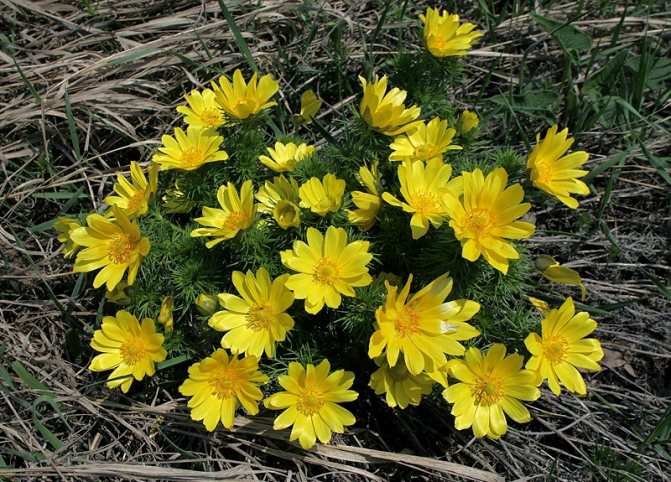

The Benten variety blooms with snow-white flowers with a fringed edge. Dense double flowers of Pleniflora adonis have a greenish-yellow tint. If you plant the Ramosa variety, it will bloom in stunningly beautiful red-brown double flowers.
Spring Adonis loves well-lit places and light fertile soil. It can be planted in flower beds, filling small areas between groups of plants. Adonis grows well in crowded areas and easily tolerates short-term drought. Sowing seeds is carried out in April or May after stratification. Plants bloom 3 or 4 years after planting.
Ipomoea purple
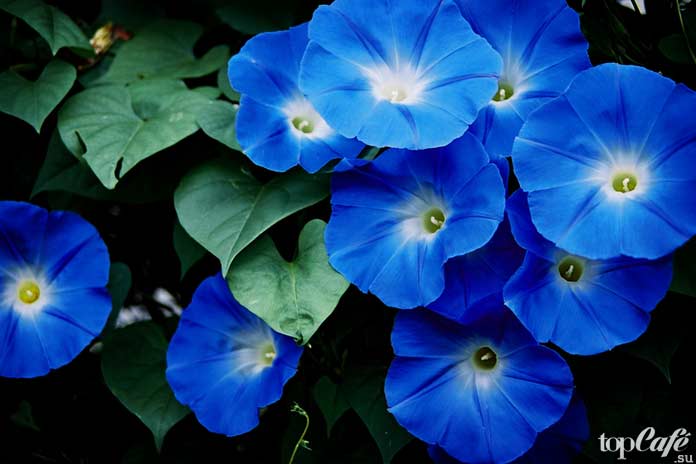

Ipomoea (Blue morning glory) blooms early in the morning to welcome the new day with its bright blue flowers. Flowers usually start to wilt on the same day. They roll up their petals, as if laying down for the night, and no longer wake up. But the next day, new sky-blue flowers appear, and everything repeats again.
The name Morning glory includes over 1,000 species of these vines from the bindweed family. They symbolize affection and love.
A few more photos of blue flowers ...
That's all! TopCafe editors are waiting for your comments with examples of beautiful blue flowers that are not included in our list.
Humble violet
For its delicate beauty and exquisite aroma, violets are loved and appreciated by many peoples of the world. Low-growing plants have been planted in the garden since ancient times. Their height does not exceed 10-15 cm. There are about 450 plant species.


As soon as the snow melts, the fragrant violet begins to bloom. She fills the garden with a delicate scent. Its flowers are colored deep purple. From the beginning of April to the end of May, the marsh violet will delight with its flowering. It is odorless and has a pleasant mauve, dark purple, or white petals. The lower petal has dark purple streaks.
Spring primroses love shaded areas of the garden. They can be planted even in deep shade. Violets need a slightly acidic, lightweight soil. You need to start planting in early March.
Variety of flowers and plants with blue and blue flowers
There are a lot of blue-blue flowers, whether they are annuals or perennials, and, creating monochromatic flower beds, there is something to choose from.
Agapanthus or African lily
Agapanthus umbrella perennial thermophilic the plant grows outdoors only in the south. In the conditions of central Russia, they are grown in a pot culture, from spring they are taken out to balconies or a garden.


Agapanthus or African lily
Sun-loving - tolerates slight shading, is moisture-loving and needs feeding once every two weeks. In winter, being on the windowsill, watering is reduced to a minimum, feeding is excluded. Transplanted as the pot is filled with roots and the bush grows.
Ageratum
Ageratum long-flowering annual a flower from the Aster family.He loves well-lit places, is thermophilic, cannot withstand even light frosts, therefore, seedlings grown from seeds are planted in open ground in the second half of May.
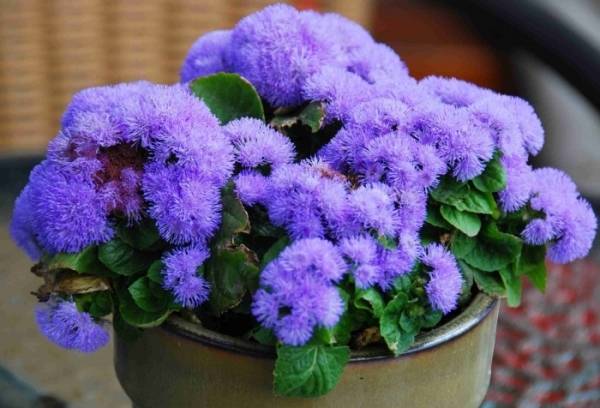

Ageratum
Ageratum is grown on light fertile soils with neutral acidity, avoiding waterlogging of the soil and fertilization with fresh manure. In care, the flower is unpretentious, loves feeding with full mineral fertilizer 2-3 times per season. Propagated by seeds.
Periwinkle
Periwinkle evergreen creeping perennial the plant grows to form a continuous carpet. The height of the periwinkle flower does not exceed 30 cm. The flower is unpretentious, it grows both in the sun and in the shade. After flowering, it needs pruning, otherwise it will displace all nearby neighbors.
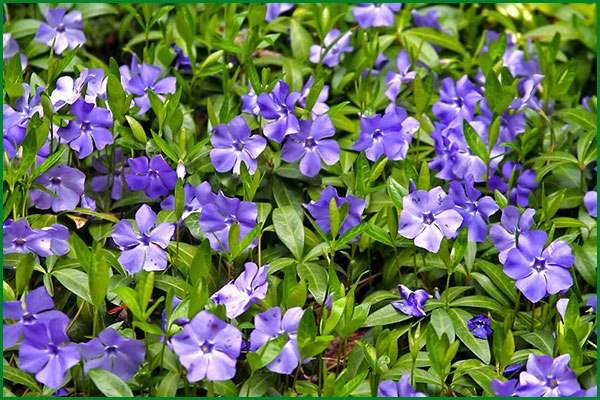

Periwinkle
Mountain cornflower
Cheerful flower - mountain cornflower. Unpretentious perennial up to 0.6 m high, photophilous, does not like the slightest shading and overdrying of the soil.


Mountain cornflower
Winter-hardy, does not require shelter for the winter. In one place it can grow up to 10 years. Cornflower is propagated by seeds. By dividing the bush.
Veronica Dubravnaya
Veronica - undersized fast growing plant, no more than 20 cm high. It can be used as a lawn, it is small and resistant to trampling, and as a ground cover. Prefers to grow on neutral or slightly acidic soils.


Veronica Dubravnaya
Hyacinths
Bulbous early spring aromatic plant up to 40 cm high. Grows outdoors and is suitable for forcing in winter. Photophilous. Bulbs are planted in light, fertile soils in September-October.
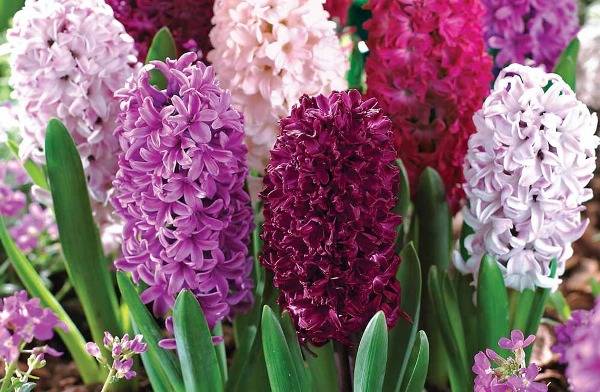

Hyacinths
Garden hydrangea
Hydrangea with blue flower caps is a noble luxury in the garden.
Deciduous shrub with lush caps of flowers, loving abundant watering and regular feeding. Delivers shading, preferably at midday.
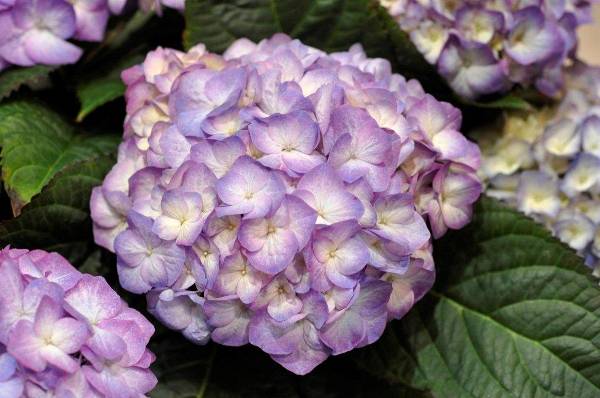

Garden hydrangea
To maintain the blue color of flowers, it is necessary to maintain the acidity of the soil pH at a level of no more than 5.5 and constantly add aluminum sulfate.
As mulch, use sawdust, coniferous bark to acidify the earth.
Delphinium
Graceful perennial plant. Loves sunny places, drought and frost-resistant. The soil for growing needs light, rich in organic matter.
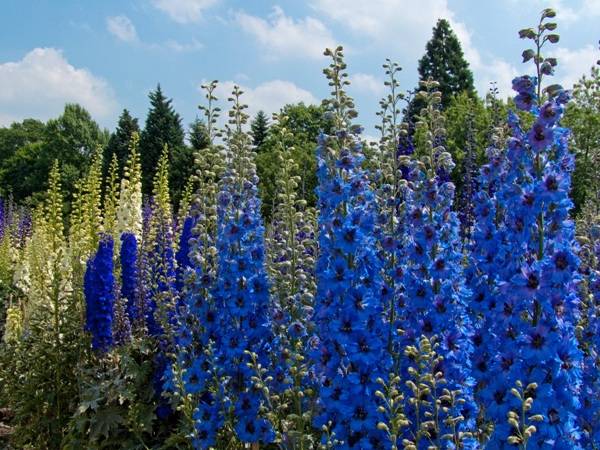

Delphinium
Beautiful when planted in groups of 5-7 pieces. For the formation of lush inflorescences, the delphinium must be fed at least three times per season. The plant is tall, so in order to avoid breaking off the stems, they must be tied to stakes.
Delphinium is propagated by seeds, dividing the bush.
Bells
- Bell middle cup and saucer
- Carpathian bell
- Platicodon or shirokolokolchik
- Bell of Portenchlag
Bells are perennial frost-resistant plants, with flowers corresponding to the name. Height, depending on the type, bells are divided into:
- tall - 1-1.5 m;
- medium-sized - 0.5-0.8 m;
- low no more than 0.15m.
Grown in sunny areas with fertile, well-permeable soils, because The bell does not tolerate stagnant water at the roots, moderate watering is needed. To increase decorativeness, fading flowers must be removed. The flower is propagated by seeds, followed by dividing the bush.
Lavender
Lavender refers to fragrant shrubs... Grows in open ground, in the middle zone of Russia, only English narrow-leaved lavender.
Loves open, sunny areas. At air temperatures below -25 ºC, shelter is required for the winter.


Lavender
After flowering, for decoration and maintaining the shape of the bush, it is necessary to cut off the lavender. Propagated by seeds, dividing the bush and cuttings.
Linen
Herbaceous thermophilic perennial loving sunny areas. After planting with seeds, like all perennials, it blooms the next year.
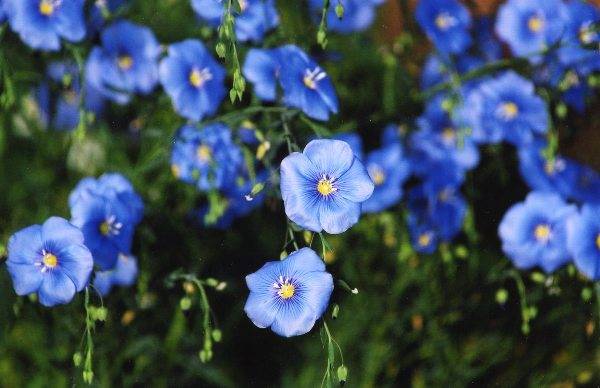

Linen
Moisture-loving and winter-hardy flax loves organic-rich soils and regular feeding. Plant height 0.3-0.5 m.
Lobelia
Lobelia is flowering fluffy bush ampelous or bush form. The height of bush varieties is up to 0.2 m, ampelous varieties form flower cascades up to 1-1.5 m.


Lobelia
At the end of the first wave of flowering, the lobelia must be cut off at a height of 5 cm from the soil, and fed. Re-flowering lasts until frost. Lobelia propagates by seeds.
Forget-me-nots
"There are forget-me-not flowers in Russia - blue as the sky ..."
Long-term unpretentious plant up to 0.2 m high. When grown in the sun, flowering is abundant. Forget-me-not is demanding for watering.
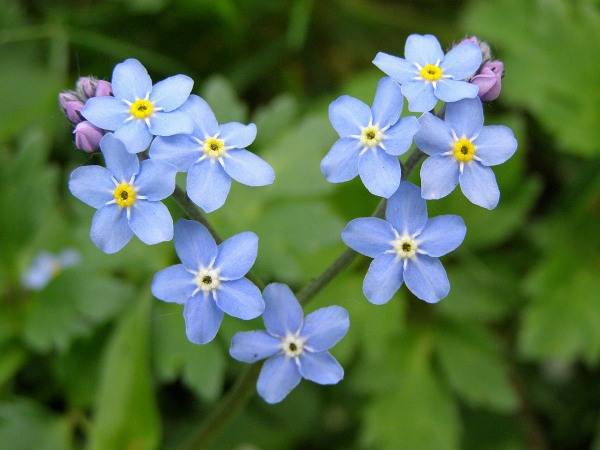

Forget-me-nots
Cucumber herb
Annual light-loving height 0.3-1.0 m propagating by self-seeding. Drought-resistant, but loving abundant watering.


Cucumber herb
Proleska
Perennial bulbous up to 0.5 m, growing both in the sun and in partial shade. Winter-hardy, moisture-loving.
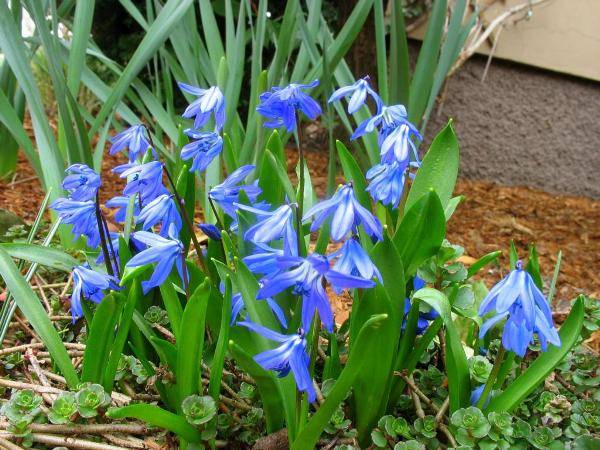

Proleska
Erythematosus flat-leaved
Perennial winter hardy a plant growing on light calcareous, sandy soils. Sun-loving, up to 0.8 m high.


Erythematosus flat-leaved
Cut flowers are used to create dry bouquets.
Chicory
Perennial flower with hard stems up to 1.5 m high. Prefers sunny places, with alkaline soils, hygrophilous.


Chicory
Nigella damask or nigella
Annual cold-resistant herbaceous plant up to 0.5 m. Grows in sunny areas, unpretentious. It propagates only by sowing seeds and immediately to a permanent place.
With insufficient watering, flowering stops.
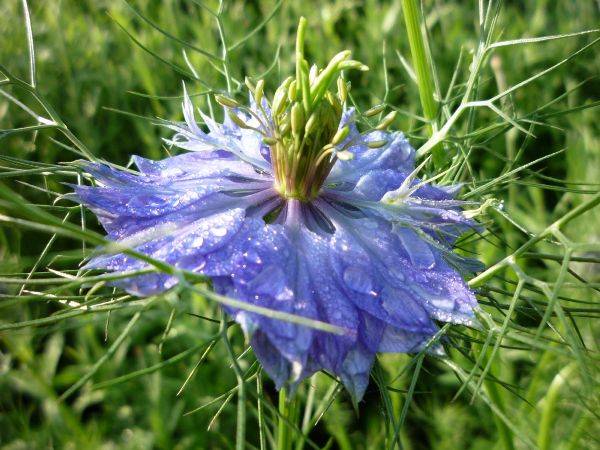

Nigella Damascus
Sage
Sage refers to perennial herbaceous winter hardy plants up to 0.7m high. Loves sunny places and fertile soil. Does not like waterlogging of the soil. Sow with seeds with preliminary germination.
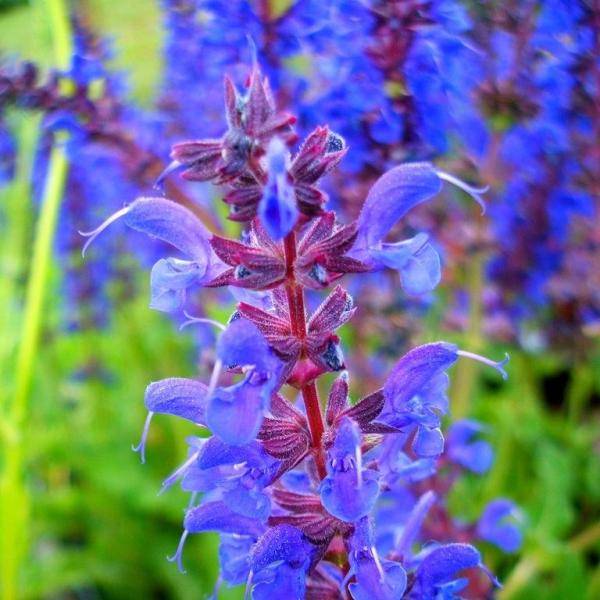

Sage
Chionodox Lucilia
Perennial undersized bulbous plant height 10-15 cm, winter hardy. When planted in the sun, it blooms one of the first, in partial shade flowering is delayed. Prefers fertile and loose soils.
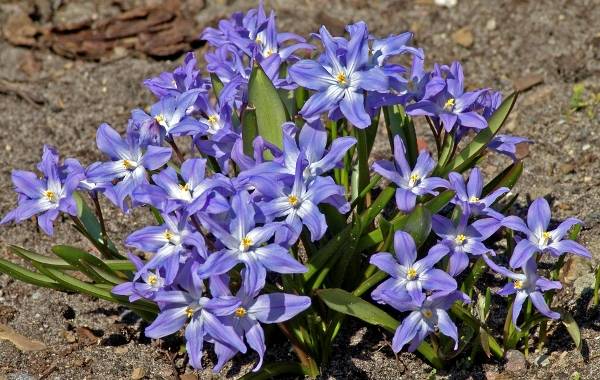

Chionodox Lucilia
The sky blue and blue tones of the flowers will bring a sense of freshness and romance to the garden.
Orchid - a combination of sophistication and sophistication
Such delicate exotic flowers are always presented in expensive exquisite bouquets, photos and names of which will not leave anyone indifferent.
To compose floristic masterpieces, the following varieties are most often chosen:
They are distinguished by large and bright inflorescences. To highlight the beauty of orchids, they are complemented with other varieties of flowers. For example, lilies, crocuses, calla lilies, delicate small roses.
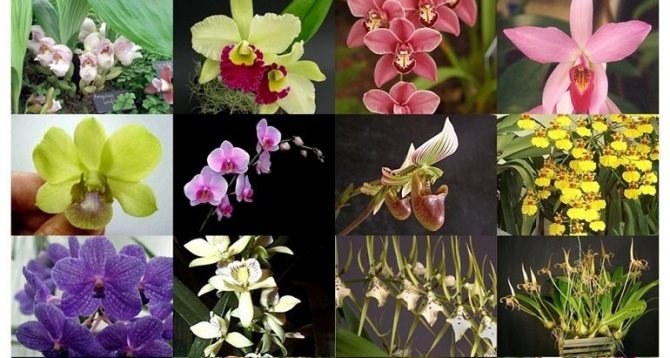

Rose - the queen of flowers
Sometimes you don't need to look for an answer to the question of what flowers are used in bouquets for a long time. It is enough to choose a classic solution - beautiful and fragrant roses that are suitable for people of different ages and both sexes.
Experts prefer to compose compositions from varieties that have a dense bud:
- Peony. They resemble a peony, have delicate outlines and predominantly pastel shades (Benjamin Britten, Miranda, Golden Celebration).
- Russian. Varieties of these flowers for bouquets stand in a vase for more than a week, they are stable in cut, emit a stunning bright aroma and are grown according to the technology invented by the Dutch (Golden Ambitia, Floribuna, Nostalgia).
- Kenyan. These are the elite and most common flowers that are added to a variety of bouquets. They are suitable for prefabricated compositions, have a thin stem, various shades and excellent decorative qualities (Ocean Song, Flamingo, Senorita, Red Ribbon).
- Ecuadorian. Such roses are suitable for composing a bouquet of flowers with the names of loved ones and loved ones. Large buds of bright shades retain freshness and pleasant aroma for several weeks (Freedom, Limbo, Movie Star, Wendela).


After the florist has chosen the main rose variety that will dominate, he makes a list of additional flowers for the bouquets. Field daisies, lilies of the valley, alstroemeria, tulips, poppies, peonies, carnations, hydrangeas and lilies go well with beautiful roses. There are other types of flowers from prefabricated bouquets with roses, their photos with names are actively displayed on forums on the Internet.
Description
Perennial, which in our climate is grown as an annual. A low herbaceous plant. Stems are tender, solitary or branching, densely leafy. The leaves are small, bright green. Flowers are collected in inflorescences, but, as a rule, they sit alone. A cup of five petals. The color scheme is quite peculiar: white, blue or bright orange. The distribution area is also unusual, different species can be found in completely different climatic zones: one in the tropics (Africa, Madagascar), one species (field anagallis) grows wild in Russia, others are common in the Middle East, Europe and America.
The popular name is full-time color.
Kermek
Kermek (limonium, statice) is a modest, charming and very beautiful plant with small flowers, which are collected in the form of umbrellas or panicles. Kermek is a frost-resistant plant. Blooms in August-October. It is used by phyto-designers to create decorative compositions. This flower attracts attention in group plantings when decorating garden plots, perfectly retains its shape if it is dried. Dried flowers stand in vases for a long time, complementing the interior of your home, and do not lose their attractiveness.
Medicinal beds
It is very beneficial to create landscaping using medicinal crops. Simple and safe medicinal plants will become not only the highlight of the garden, but also a real home medicine cabinet.
What are the medicinal flowers:
- Polemonium (azure cyanosis) is an abundantly flowering melliferous plant of the Cyanus family. The flowers are large, bell-shaped, deep blue, gathered in a panicle. The roots of the plant have medicinal properties.
- Snakehead is an annual of the Yasnotkovye family. The stem is erect, grows up to 70 cm. The flowers are pale purple with a bluish tinge. Leaves, stems and flowers have a lemon scent. Used to prepare tea drinks, added to some dishes.
- Cynoglossum is a melliferous plant with dark purple-blue flowers. For the preparation of lotions, roots and leaves are used, dry stems scare away mice.
- The tricolor gentian is a beautiful but very bitter plant. The flowers are blue, bell-shaped, up to 3 cm in length. For the preparation of decoctions and infusions, the herb and flowers of the plant are used.
- Hyssop is a compact shrub with straight branchy shoots and blue flowers. Has a bitter-spicy taste. Dried parts of the plant are used in folk medicine, for flavoring dishes, making drinks.
- Chicory is a perennial of the Astrov family. In large inflorescences, blue-blue ligulate flowers with a diameter of up to 4 cm are formed. Chicory belongs to valuable melliferous plants, blooms from June to October. For medicinal purposes, decoctions of herbs and tinctures from the roots are used.
Which plants to grow depends on personal preference and overall garden design. The main thing is that the flowers create a festive atmosphere, fill the garden with pleasant aromas, and in the autumn period decorate with bright foliage and unusual silhouettes.
Astilba
This plant most of all attracts the owners of country houses, because with the help of it you can wonderfully decorate the local area. Planting and caring for astilbe itself is painstaking work, since it is a perennial plant. It has many species, which can be short, and tall, and medium, and even dwarf in size. The plant is crowned with inflorescences in the form of panicles, which can be of different colors.In matters of care and planting, astilbe has its own requirements: it should grow in partial shade, the land should be enriched with humus, watering should be carried out on a regular basis. The flower is very afraid of excessive watering, the roots instantly rot. It is necessary to remove the peduncles when the flowering period is over.
Exotic and rare flowers
Not all bush flowers for bouquets, the colorful photos and names of which we have considered above, can surprise a fastidious lady or an artsy gentleman. Rare flower arrangements from the following options are more suitable for them:
- Gloriosa is an exotic beauty for unusual and bright solutions.
- Amaranth is an amazing plant with hanging inflorescences.
- Brassica is an unusual flower for wedding arrangements and festive decorations.
- Celosia - similar in texture to a carnation, often complements other plants in voluminous and lush compositions.
- Spherical craspedia will certainly become the central flower in the autumn and winter composition.
- Tillandsia Xerographica is a rare flower that looks like a jellyfish. Its swirling grayish long leaves look great in vintage bouquets.
- Echeveria - goes well with dahlias, often used for winter bouquets with eucalyptus and dried flowers.
- Astilba is a romantic ornamental plant with elongated, fluffy and lush inflorescences.
Rare garden and wildflowers will undoubtedly charm and leave a lot of pleasant emotions and impressions. With proper care, they stay in the vase for a long time.


Bell


When discussing blue flowers, bells come to mind first. Its book title is Campanula. Bells are annual, perennial, biennial, it all depends on the variety. From the subspecies of the Japanese bell, the Takeshima variety cannot be missed. The flowers are blue in color with double or simple leaves, the height of which is about 0.6 m. If there is a round bell, then it is classified as undersized (0.4 m in height). Professionals use this type to decorate borders, which gives them a unique look, especially when the plants are originally cut.
This plant loves a climate where everything is in moderation - heat, cold. In Latin, its name is Campanula. As in Russian, the name is tied to the shape of the flower, because it looks like a bell.
The flower is unpretentious. It can grow in the shade and in the sun. Popular varieties have long, tall stems that can reach heights of up to one and a half meters. The leaves are arranged in a herd, have an oblong shape. Inflorescences are paniculate, sometimes of the same color. The bell itself is quite large (up to seven centimeters). In the center there are three stamens and one pistil. Various colors can be observed from blue, blue, violet to white.
Each flower has its own season
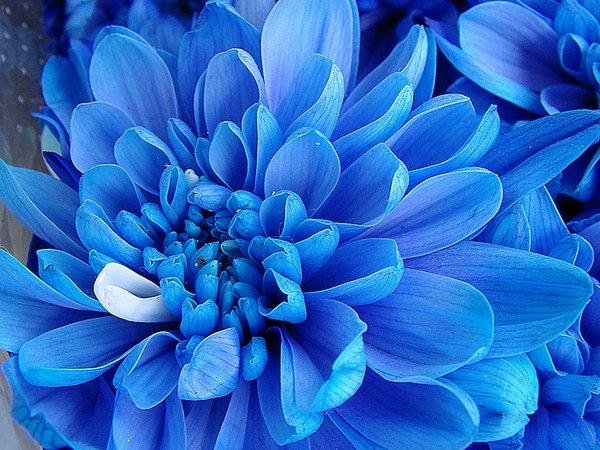

Blue flowers are present in petunias, violets, lobelias in the warm season. Blue flowers, the names of which are known to everyone, are irises, cornflowers, and bells.
In March, blue hyacinths will be beautifully set off with carnations, tulips, red pelargoniums. Against the background of the snowy whiteness of daffodils, blue flowers look great. What different color combinations mean, explains floristry - one of the directions of aesthetics.
The largest number of plants with dark blue flowers can be found in the height of summer. These are the revered iris, anemone, delphinium, gentian. By the month of August, the blue leader's baton is picked up by a bell.
Original color combinations
Florists are increasingly using blue, purple and blue flowers when creating their creations, which are suitable for a bouquet for both a man and a woman, we will consider their names and photos below:
- Spathiphyllums are small decorative flowers that are most often presented in baskets.
- Scylla or Proleski are fragrant spring primroses similar to blue snowdrops.
- Liverworts or coppices are spring flowers of bright blue color, they are arranged in a basket or in a large leaf with lilies of the valley or other small primroses.
- Mouse hyacinths or Muscari are small flowers for prefabricated and mono-bouquets, radiating warmth and tenderness.
- Freesias are one of the most original flowers, embodying fragile charm and sophisticated aristocracy.
- Lilies of the valley are more often found in nature in white, but there are blue and pale purple varieties.
- Lilac is the classic twig of this spring flower, which is sure to be a focal point among smaller plants, or the perfect complement in combination with tulips or peonies.
- Crocuses - these voluminous and bright primroses are a symbol of cheerfulness and the onset of the first days of spring.
- Clematis is a climbing ornamental plant with small blue flowers, which are often decorated with floral arrangements for the bride.
- Veronica - small flowers, similar to an ear, have different colors, from dark blue to pale blue.
- Cornflowers are shy and simple flowers - ideal for creating a voluminous field bouquet.
Of course, this is not the whole list of colors that have a violet, cyan and blue tint. Breeders have long bred hybrid varieties of roses, hydrangeas, chrysanthemums, orchids, forget-me-nots, delphiniums, which will emit their “heavenly” color next to pale pink, yellow or red flowers, live branches of berries or ornamental grasses.
Chrysanthemum - golden flower
Varieties of these flowers are widely used to compose gift bouquets, their names and photos are in many reference books for florists:
Chrysanthemums of pink, yellow and red shades are widespread. They are delivered to flower markets all year round. These are ideal flowers for professional bouquets, their photos and names are pleasing to the eye, and the live composition looks just wonderful. It is worth not fading for several weeks, just changing the water is enough.


Gladiolus (skewer)
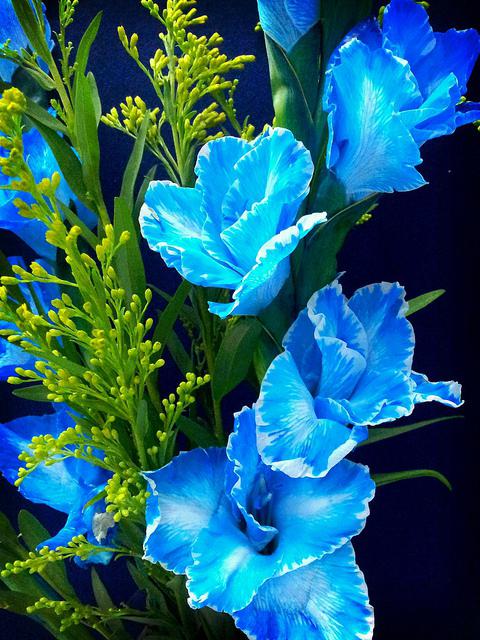

He is considered the king of victory and an excellent duelist. In the photo of blue flowers, gladiolus has a tall, slender stem and beautiful flowers collected in a straight, pointed spike.
This is a male flower, reminiscent of chivalry and victory. It is very rare for women and girls. Gladioli look good in bouquets and are intended for business partners. They are presented to the winners and laureates of various awards.
Many legends are associated with this flower. Shamans endowed it with magical properties. The ancient Romans used gladiolus as an amulet and believed that such a talisman would bring victory over the enemy.
Despite being whimsical to grow, these flowers are considered a favorite and well-known in our gardens. Blue gladioli look unusual and solemn. They grow independently and in compositions with other flowers, they are used to decorate flower beds and flower beds. Cut gladioli, placed in vases, perfectly complement the interior of your home.
Flowering table and flowering period
| April-May | May June | June August | August-October |
| Anemone coronaria | Aquilegia-Aquilegia | Aconite-Aconite | Cicerbita |
| Brunner-Brunnera | Periwinkle-Vinca | Ankhuza-Anchusa | Wide bell-Platicodon |
| Hyacinth-hyacinthus | Cornflower mountain-Centaurea montana | Baptisia-Baptisia | Cyanosis-Polemonium |
| Tenacious-Ajuga | Hyacintoides-Hyacinthoides | Veronica-Veronica | |
| Crocus-Crocus | Colnik-Phyteuma | Lupine-Lupinus | |
| Muscari-Muscari | Lungwort angustifolia-Pulmonaria angustifolia | Blue onion - Allium caeruleum | |
| Primula-primula | Forget-me-not-Myosotis | Mertensia-Vlertensia | |
| Proleska-Scilla | Umbilical-Omphalodes | Eryngium-Eryngium |
Which brides are suitable for?
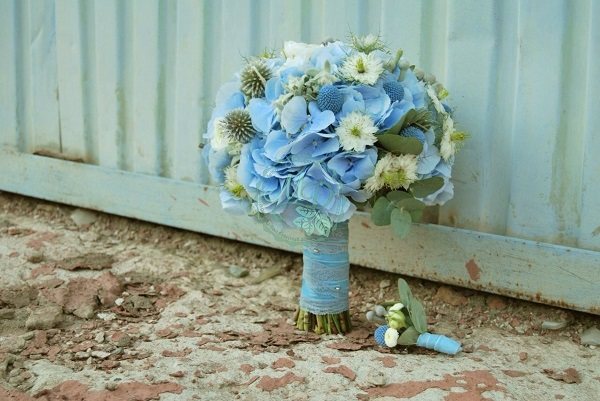

Blue is versatile. It perfectly sets off the fresh beauty of a very young girl and makes the image of an older woman sublime and mysterious.
Blue bouquets seem to be created for shining spring and hot summer. They add a fresh accent that fits perfectly into the surrounding reality. But also golden in autumn or contrasting white in winter, shades of blue look worthy, recalling airiness and romance.
As for the color type of the bride, here too a wide palette of blue tones will allow you to choose a suitable option for both a gentle blonde and a burning brunette or a bright red-haired lady.
Interesting! Do not think that blue is combined only with pastel colors, bright colors suit him no worse. Deep blue, carefree yellow, enchanting blue - all these options, despite the rather high contrast, look very elegant.
Blue goes well with white. This composition looks incredibly fresh and solemn. Beige or pink will make the heavenly shade even more delicate, sublime, romantic. If you want to add more mystery to the blue bouquet, then feel free to choose a lilac pair with it.


Most often, the blue bouquet is present at themed non-standard celebrations., and indeed - such an accessory is ideally combined with a straight or Greek dress, high waist, natural fabrics.
Care
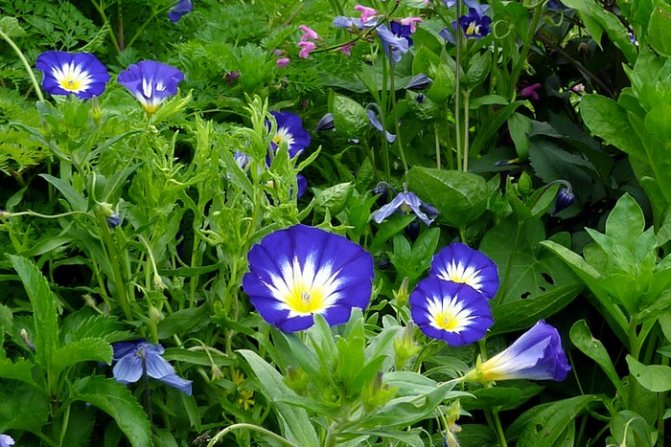

Grows well on moderately fertile soils, medium dense and preferably neutral. Any soil is recommended to be mixed with garden soil and plenty of well-distributed compost. On poor soils, a dose of fertilizer in the spring before planting and during flowering will be helpful. During periods of prolonged drought, watering is required. Before planting, you need to think about where to plant, because the plant hates transplanting. Faded flowers should be removed regularly.
When growing in pots, a prerequisite for success is applying a sustained release fertilizer to the soil and keeping the substrate slightly moist at all times. Otherwise, the flowers will fall off, the leaves will dry out irreversibly.
Samples
It would be a mistake to smear on paper and try to understand something by the result, because I will use paint in painting miniatures, on a non-absorbent surface with complex geometry, and I must try it. In addition, you must immediately exclude the desire to paint any figurine completely, this is just a test daub, detailed painting will take a lot of time and for this reason, many of the nuances of new colors may be hidden behind a complex painting.
I chose stale miniatures that I would hardly have undertaken to paint in the foreseeable future:
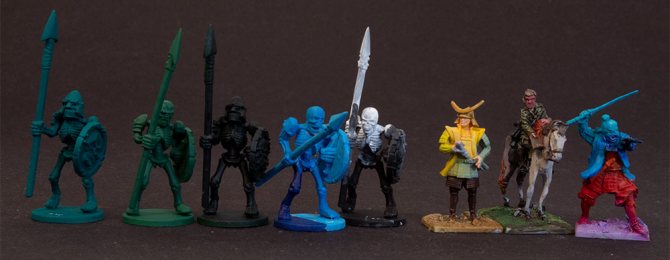

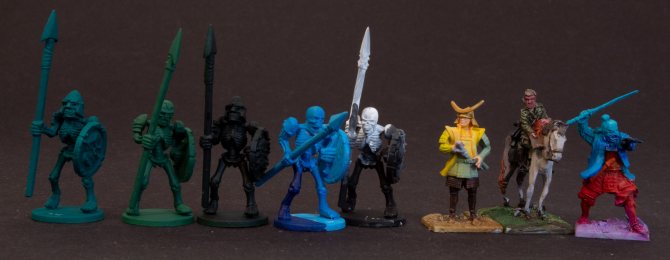

... Will anyone be able to find the places painted by "Ladoga".
Figures of skeletons from left to right, painted: Ladoga "FC green", Scale Art "Sap green" with whitewash and it is not whitewashed. The left side with a blue figurine is painted with a fret, and the right side is Scale Art, with a black one. On the remaining three minks I tried Scale Art exclusively.
I started by comparing the paint "Sap green" with the dominant p.G.7 with a similar one from "Ladoga". In "Scalecolor Art" the seventh blue is not whitened, but in domestic ones it is exceptionally strongly lightened, I had to add titanium white to get a result close in lightness. Leaving behind a slight difference in hue (see above in the set with greens), Ladoga has a slightly more saturated sonorous color. Both coatings have the lightest sheen (the nature of phthalocyanine pigments), but ours has a little less. I applied paint from an airbrush, "Scalecolor Art", as expected, required less consumption and was applied faster.
Then I applied pure "Sap green" separately, once again making sure of the brilliance of paints consisting of phthalocyanine pigments. A slight satin sheen of course, but this is not an ultra-matte surface at all.
Of course, it was necessary to compare the fifteenth blues, which in "Scalecolor Art" are given exclusively in strong lightening, on the contrary, this time we had to whiten the paint from "Ladoga". It turned out very similar, but the domestic color came out subtly less pure. In addition, the Spanish offer two paints based on different modifications of p.B.15.
The difference in approaches is interesting, in "Scalecolor Art" case green phthalocyanine is given in a saturated form, blue - whitened, and in "Ladoga" it is vice versa. Surely in our paints there is also a limitation of the palette, not such capital ones, according to which too saturated green would interfere more.
Comparison of white and black showed the best hiding power of Spanish whitewash. The lightest shine of “Art black” turned out to be surprising in comparison with the ultra-matte domestic “gas soot”. Not important, but still.
On the remaining figures I tried different colors (one is not in the photo, only later I checked brown and gray on it). It is immediately visible, despite the application of paints directly from the tube - all colors are harmoniously combined with each other. The result is not richer than what is available from "Ladoga" (in violet and orange, ours will clearly surpass these colors). "Scalecolor Art" is more opaque, often two or three thin layers are required to cover the substrate, but with the domestic one it happens that six layers are not enough. The consumption will be less than that of cheap acrylic.
Separately, it is worth noting the behavior of paints with strong dilution, the consistency for painting a small miniature. "Scalecolor Art" shows excellently, in contrast to "Ladoga", a more uniform, smooth layer is obtained. A little experience of working with close related gray paints "Scalecolor" shows that it is much easier for them to get a high-quality smooth transition ("Ladoga", when diluted significantly, produces an unevenly colored layer, often you have to fight more with unpredictable spots formed, for a long time and to the detriment of the smoothness of the gradient) ...
In terms of fineness, in my experience it affects mostly the mixing strength of paints, whether it will dominate the new color and by how much. It is precisely because of the fine dispersion that phthalocyanines are so strong in mixtures (the smallest particles are more likely to bypass large ones). I don’t understand why much attention is paid to this characteristic.
Delicate and refined lilies
Before collecting a bouquet of lilies, it is better to study the names and photos of its varieties, because these unusual flowers are not always combined with each other. At all times, the lily was considered a symbol of purity and purity, therefore it is most often chosen to decorate a wedding celebration. There are the following varieties of lilies:
- Cream and white - Dewdrop.
- Pink and Lilac - Sonata.
- Orange - Wave.
- Yellow - Autumn Song.
- Red - Scarlet Sails.
Bright orange, yellow and burgundy flowers go well with delicate light bells, daisies, irises. You don't need to think long about what flowers are added to chic bouquets with lilies. These are sprigs of mimosa, and jasmine, and small bush carnations. Each florist compiles his own list of names of beautiful flowers for bouquets with photos and a detailed description of how to create a unique composition.
Unusual hydrangea
This garden shrub will decorate landscape compositions, gazebos and paths. Blue-flowered hydrangeas are large-leaved hydrangeas. They have rounded inflorescences that bloom for a long time and profusely. Blue flowers are of the following varieties:


"Mini Penny" is a remontant variety with lush green foliage and spherical flowers of pale blue shades.- "Ramars" - the flowers of this compact bush can be multi-colored: either purple and violet, or blue-white.
- "Freedom" - only blossoming flowers have a pink tint, which gradually changes to pale blue with white edges.
- "Compeito" - the flowers of this hybrid variety are lilac-blue in color, over time their color becomes deep blue.
- "Performance" - at the beginning of flowering, the flowers are pink, gradually they turn blue.
- "Hopcorn Blue" - Tulip-like blue flowers. It begins to bloom in the second year.
- "Jomari" - double flowers, blue.
Roses of New Jersey: characteristics of the variety and recommendations for care
Many varieties are able to change their color from one to another during one summer on their own.If you want to change the color of the bush, it must be watered with a solution of aluminum alum during budding (2 liters of water for 1 tsp of alum). In this case, the white hydrangea will turn blue, pink - lilac, and purple - blue-blue.
What garden styles is blue used in
Trust me, you can create a monochrome blue garden in any style you choose. Laconic and discreet, blue can transform any garden area. We will introduce you to the most famous ones.
Mediterranean charm
Nature has made sure that you have no shortage of plant choices if you are considering creating a Mediterranean garden. Lavender and thyme, sage and rosemary - they all delight with shades of blue and purple tones. And what aromas!
Place large terracotta pots covered with a noble patina around the garden, plant slender rocky junipers or columnar thuja. (They serve as a great substitute for whimsical southern cypress trees.) Your Mediterranean-style garden is ready!
Laconic lines of Art Nouveau
The most drought-resistant and unpretentious plants are the symbol of Art Nouveau. For example, irises with their narrow, xiphoid leaves and exquisite inflorescences in various shades of blue and purple. Or simple verticals of blue sage, catnip, or lavender.
Romantic garden
What is a romantic garden without blue, lilac and pink flowers? Here you shouldn't get carried away with deep dark tones, you should choose a lighter, more cheerful color scheme. Winding paths, arches and pergolas with clematis and roses decorate your garden and create the privacy you need.
If you dreamed about blue flowers, what does it mean?
If you dreamed of a flower with blue flowers, mystical events await you. But they will not scare you, but will cause a lyrical mood. Blue flowers in a dream portend calmness in relationships and waking affairs, speak of the nobility of the actions that you will perform. Such a dream promises respect for the people around you. However, a flower with blue flowers speaks of depression associated with unrequited love. If a man has such a dream, in reality it portends a quick meeting with an unapproachable, but very beautiful woman. A blue rose in a dream is a good sign. Get ready for a new stage in life, there will be no return to the past.
cornflower
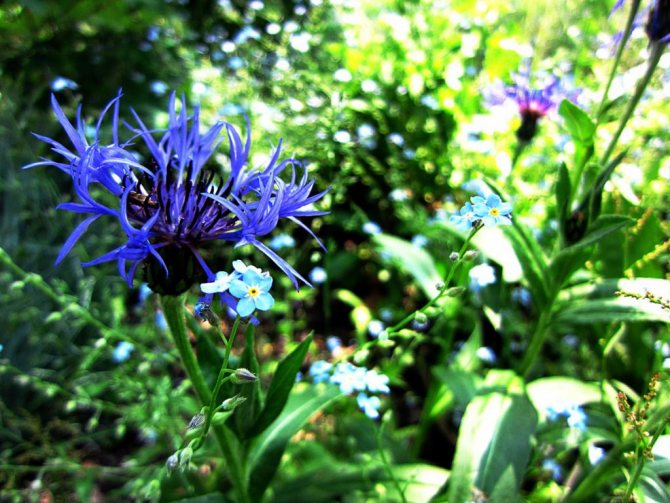

This flower can be found in fields, forests, gardens, near rivers, in vegetable gardens. It is considered a weed. Despite this, it has a beautiful view.
If you use a cornflower to decorate your flower garden, then the composition in which it will be included can surprise and charm even the most demanding flower growers. This plant has a stem 25 to 100 cm long with a rough long surface. The flowers are beautiful and brightly colored.
Growing
To grow this flower, you need to purchase seeds or seedlings. The main thing when choosing a seedling is a visual inspection for damage. A good seedling has bright green leaves and a strong trunk, yellow foliage indicates a plant disease.
It is not recommended to acquire flowering crops, they take root worse. Planting is best done in the second half of April, if the seedling is purchased in the fall, then you can plant it in a pot and store it in the cellar until spring.
It is better to plant in groups. You need to dig a hole that is slightly larger than an earthen root ball, and its width should be three times larger. Drainage must be placed in the pit, it can be sand and humus. Then insert the seedling into the hole, spread the roots well, cover with earth and water.
It's important to know: karyopteris does not require frequent watering, it is a drought-resistant shrub.
Seeds are best planted in the soil in late autumn or early spring. It is recommended to plant them in pots, they are scattered over the soil without sprinkling. Then they cover it with a film, it turns out a greenhouse. The film is periodically removed for ventilation and irrigation.After 2 weeks, seedlings appear, after the appearance of 3 leaves they dive. In early May, seedlings can be planted in open soil.

